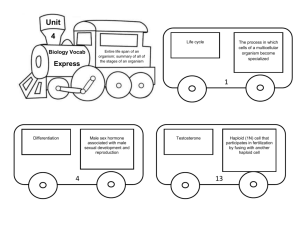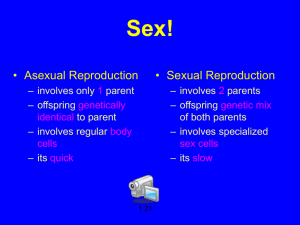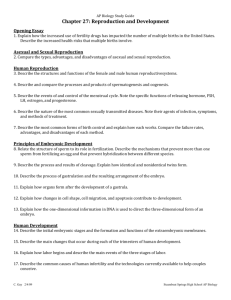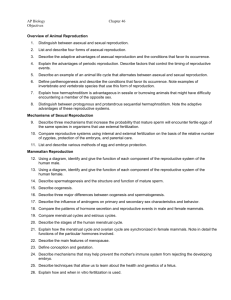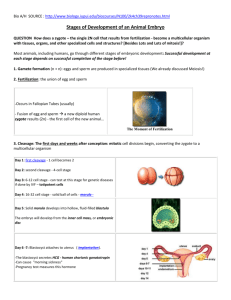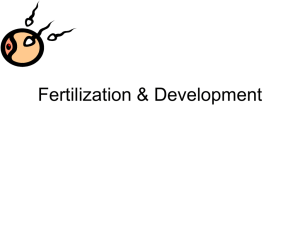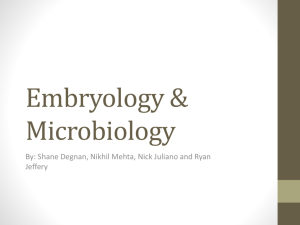biology - Kendriya Vidyalaya No.3 AFS, Nal, Bikaner
advertisement
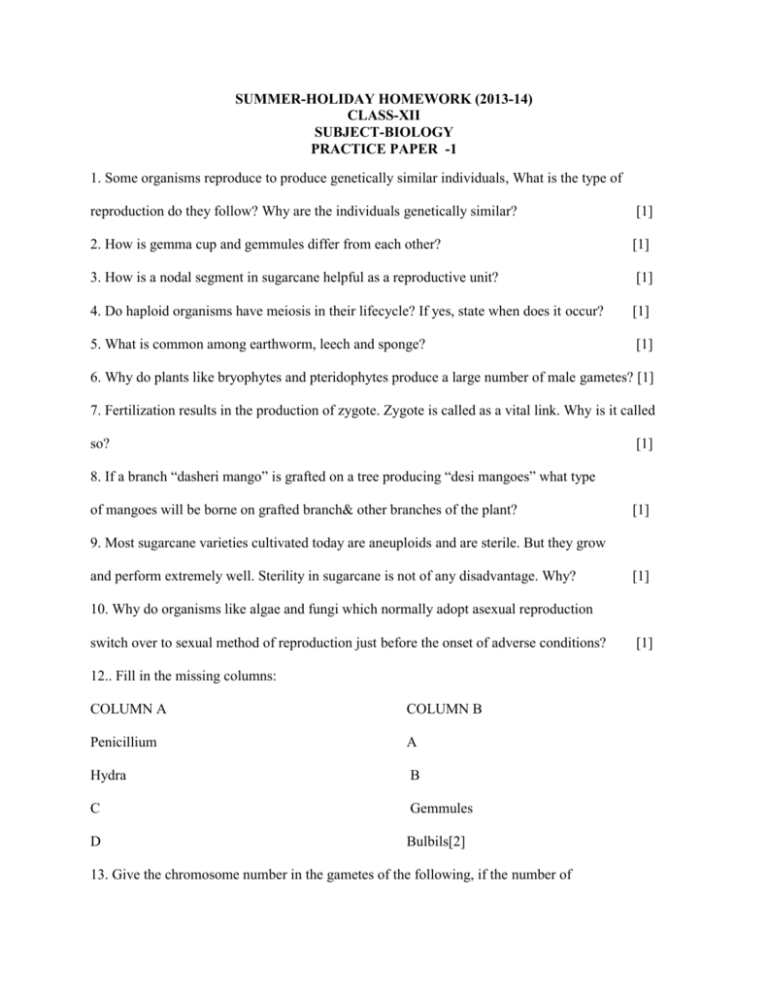
SUMMER-HOLIDAY HOMEWORK (2013-14) CLASS-XII SUBJECT-BIOLOGY PRACTICE PAPER -1 1. Some organisms reproduce to produce genetically similar individuals, What is the type of reproduction do they follow? Why are the individuals genetically similar? [1] 2. How is gemma cup and gemmules differ from each other? [1] 3. How is a nodal segment in sugarcane helpful as a reproductive unit? [1] 4. Do haploid organisms have meiosis in their lifecycle? If yes, state when does it occur? [1] 5. What is common among earthworm, leech and sponge? [1] 6. Why do plants like bryophytes and pteridophytes produce a large number of male gametes? [1] 7. Fertilization results in the production of zygote. Zygote is called as a vital link. Why is it called so? [1] 8. If a branch “dasheri mango” is grafted on a tree producing “desi mangoes” what type of mangoes will be borne on grafted branch& other branches of the plant? [1] 9. Most sugarcane varieties cultivated today are aneuploids and are sterile. But they grow and perform extremely well. Sterility in sugarcane is not of any disadvantage. Why? [1] 10. Why do organisms like algae and fungi which normally adopt asexual reproduction switch over to sexual method of reproduction just before the onset of adverse conditions? 12.. Fill in the missing columns: COLUMN A COLUMN B Penicillium A Hydra B C Gemmules D Bulbils[2] 13. Give the chromosome number in the gametes of the following, if the number of [1] chromosomes in their meiocytes is as follows: i.) Dog-78 ii) Rice – 24 iii) Housefly – 12 iv) Butterfly -380 [2] 14. Reptiles and frogs are oviparous animals; yet they differ in certain aspects of reproduction. Bring out the differences and mention which of the two animals has more advantage. Give one reason. [2] 15. Name a plant where vegetative propagation occurs from reproductive organ. What is the special name of the reproductive part of the plant? [2] 16. In non-primate mammals like cows, sheep, rats, deer etc, the cyclical changes that occur during reproduction are called oestrus cycle whereas in primates it is called as menstrual cycle. How can we distinguish between them? [2] 17. Do you agree with the statement only asexual reproduction can give rise to individuals resembling their parent? Support your answer with an example. [2] 18. Categorise the following plants based on the floral characteristics: Hibiscus, Cucumber, Papaya, Guava. [2] 19. Sexual reproduction involves fertilization and the formation of embryo. What are the critical events needed for the successful reproduction process. 20. [2] i) Identify the given plants. ii) How are they different from each other with regard to reproductive organs theypossess . A B 21. In a pond ecosystem you may find the plant with purple flowers that spread very fast to cover the entire pond within a short span of time. How does it spread? How does it harm the aquatic body?[3] 22. Can we consider simple cell division as a method of reproduction? What will you call this kind of reproduction? Give two examples in support of your answer.[3] 23. Study the following diagram and answer the questions given below: i. What does S and P denote? ii. Where do they develop from? iii. What is the term given to the point of attachment of the ovules in the fruit? iv. What is the ploidy of embryo and the tissues in the ovary? v. What is the function of fruit apart from storage of materials? [5] 24. Fertilization leads to the formation of embryo. i. Give the technical term for the development of embryo. ii. What are the events that occur during embryo development? iii. The development of zygote depends on two factors. What are they? iv. How will you categorise animals based on the development of zygote inside or outside the female body? v. How does zygote in fungi and algae overcome dessication? [5] PRACTICE PAPER-II CHAPTER -2 1. What is the advantage of making the hybrid seeds in to apomicts? [1] 2. What is pericarp ? Mention any two of its functions ? [2] 3. How does the flower of maize and cannabis are pollinated? What are the features found in these flowers for such type of pollination? [2 ] 4. Identify the type of flower shown in A and B. Which out of the two will produce an assured seed ? [2] 5. (i)Draw a labelled diagram of the sectional view of a mature pollen grain of angiosperms. (ii).Explain the function of any two of its parts. [3] 6. Draw a labelled diagram of L.S. of an embryo of grass (any six labels). [3] . 7.Explain different stages of development of female gametophyte in angiosperm. [3] 8.Define (i) emasculation. (ii) sporopollenin (iii) coleoptiles. Give reasons why: (i) most zygotes in angiosperms divide only after certain amount of endosperm is formed. (ii) groundnut seeds are exalbuminous and castor seeds are albuminous. j (iii) Micropyle remains as a small pore in the seed coat of a seed. (iv) integuments of an ovule harden and the water content is highly reduced, as the seed matures. (v) Anthers of angiosperm flowers are described as dithecous. [5] 8..A student wants to know the ploidy of coconut. After studying its different parts he inferred the ploidy of the following parts. Check whether the student is correct. [5] (a) Water inside the fruit-n (b) White Kernal-2n (c) Seed coat-n (d) Embryo-3n (e) Tepal-2n. PRACTICE-PAPER-III CHAPTER -3 1. How many eggs do you think were released by the ovary of a female dog which give birth to 6 puppies ? [1] 2. Name the embryonic stage that gets implanted in the uterine wall of human female. [1] 3. Fill in the boxes [2] 4. Furnish the technical term for the following(a) Semen without sperm (b) The finger-like projections appearing on the trophoblast after Implantation. [2] 5. Represent diagrammatically the process of spermatogenesis in a human male, indicating the number of chromosomes at various stages ? [3] 6. Draw a labelled diagram of female reproductive system. [3] 7. Explain(a)Why does zona pellucida layer block the entry of additional sperms? (b)Sperm cannot reach ovum without seminal plasma. (c) All copulations do not lead to fertilization and pregnancy [3] 8.Write the function of the following (a) Corpus luteum (b)Endometrium (c) Acrosome (d) Sperm tail (e) Fimbriae [5] 8.A woman has conceived and implantation has occured in her uterus. Explain the sequence of changes upto parturition which take place within her body. [5] 9.Study the diagram and answer questions that follows: [5] a.What is the role of corpus luteum in menstrual cycle? b. Why is luteal phase otherwise called as secretory phase? c. How is estrogen related to menstrual cycle? d. How does FSH and LH regulate the menstrual cycle PRACTICE-PAPER-IV CHAPTER -4 1. A doctor has been observed the chromosomal disorders in developing foetusand advised the couple to undergo abortion. suggest the technique by which doctor observed the chromosomal disorders. [1] 2. At what stage Zygote can be introduced in the fallopian tube in Zygote IntraFallopian Transfer [1] 3. Name two sexually transmitted diseases caused by viral infection? [1] 4. What is lactational amenorrhoea ? [1] 5. Which Institute has developed Saheli? [1] 6. What are adventages and disadventages of amniocentesis? [2] 7. What are the two main objectives of RCH ? [2] 8. Identify the given diagram. What it is used for? [2] 9.Describe barrier method of birth control. [3] 10.Copper ions-releasing IUDs are more efficient than non-medicatedmethods. Why? [3] 11. Fed up of large famly a couple decided to adopt a suitable birth control method . Name the method and describe its procedure for male and female? [3] 12. Expend the given terms- RCH, MMR, RTI, MTP, CDRI [5] 13.Fill a, b, c, d & e for the given column I and II. [5] S.NO COLUMN I 1 IVF and ET 2 b COLUMN II a introduction of Zygote orembryo with more than 8 blastomere into uterus . 3 Introduction of ova of a donor into Fallopian tube. d 4 5 c ICSI e Introduction of semen into the uterus of human female artificially

